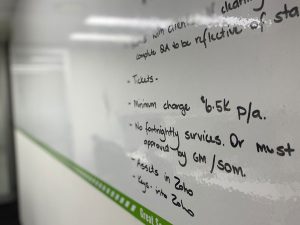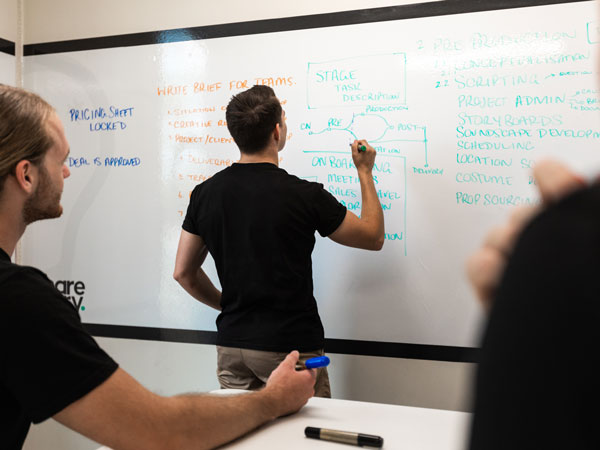White space… is there anything worse when you are doing creative planning. Staring at The Dreaded Blank Whiteboard with just a heading to ‘get you started’ can be a daunting task.
“How to improve our systems”
“Increase sales for the next quarter”
“Get more online reviews”
If this is your only starting point, you’re in for a tough few hours in the meeting room. Brainstorming, either by yourself or with a team can be tricky. However, if done correctly it can have a huge impact on your business.
The Natural Planning Model
 Having a simple and structured approach to brainstorming sessions is essential to overcoming The Dreaded Blank Whiteboard. David Allen, the author of the super-successful time-management book Getting Things Done, developed The Natural Planning Model specifically for this purpose.
Having a simple and structured approach to brainstorming sessions is essential to overcoming The Dreaded Blank Whiteboard. David Allen, the author of the super-successful time-management book Getting Things Done, developed The Natural Planning Model specifically for this purpose.
The Natural Planning Model is an informal approach to planning that enables a large amount of value from a seemingly minimal amount of effort – and it works. Let’s take a look at the five simple steps involved in supercharging your brainstorming for business success so you can avoid The Dreaded Blank Whiteboard.
Step 1: Start with Why
Like many goals, projects or problems it’s important to start with why. Why you need to do it, why it’s important to you and also the business. What deep-seated benefits will it bring?
Example: Workplace health and safety is important to us. Proper attention on this enables us to feel safe and return home to our families after work.
Step 2: The End In Mind
What does the ideal outcome look like? How do you define success? Make this part measurable – this will enable you to not only have a clear direction, but also allow you to measure the results at the end of the specified period.
Example: We want a 15% decrease in workplace accidents by the end of the year.
Step 3: Brainstorm Your Ideas Now you have a purpose and direction written down, get your ideas flowing. We are going for quantity not quality in this instance. Don’t dismiss an idea and fail to write it down – it may lead to another idea or could be used in another project down the line. There are no wrong answers for this task. This approach is particularly useful with group brainstorming sessions.
Now you have a purpose and direction written down, get your ideas flowing. We are going for quantity not quality in this instance. Don’t dismiss an idea and fail to write it down – it may lead to another idea or could be used in another project down the line. There are no wrong answers for this task. This approach is particularly useful with group brainstorming sessions.
Example: Improve safety signage; Conduct a Safety-themed week around the company; Offer rewards for good safety practices
Step 4: Organise It
By now, you should have a whiteboard full of new ideas and concepts. It’s time to organise them, assign them, prioritise and file. More on this in a moment…
Step 5. Next Action
This part is super important to get traction on your project towards the end goal. Allocate the resources needed to move the project forward and decide the Next Actions for each member. This way, they have a starting point to move ahead.
 Tools for Organising, Planning and Tracking
Tools for Organising, Planning and Tracking
You can do this all on a blank sheet of paper with a cup of coffee and some quiet time. But ideally, you want a decent sized whiteboard for the initial planning session and some online tools to help organise and track the results.
After we’ve finished in our planning room, we move all the content into Trello, a project management tool. You could also use Asana, Monday or To Doist. Keeping a regular check on the actions, goals and priorities with scheduled check ins for accountability, will ensure your brainstorming of ideas comes to fruition, hopefully smashing that end goal in the process.
Need a whiteboard to supercharge your next planning session? Get in in touch with us today.
Want to learn more on David Allen and his methods? You can check him out here.
